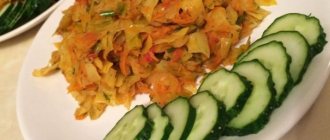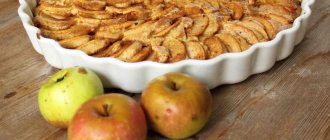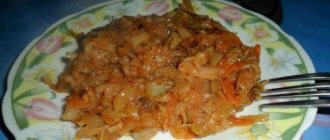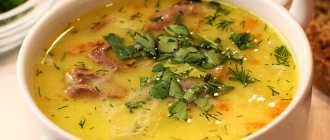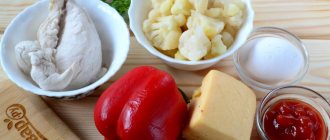I cook sausages myself, but I am 100% sure that it will be delicious from meat. Sharing the recipe
What does the casing of modern sausages hide behind? Perhaps only experts in some laboratory can find out. And we, mere mortals, have to be content with the information on the packaging. But it’s not a fact that the meat will consist of pulp and fat for juiciness and fat content... So why risk yourself and your loved ones? Make your own homemade sausages.
When I said that sausages are 100% meat, I was lying a little. You can’t get juicy and tasty sausages from meat alone. But I guarantee 100% naturalness of our dish.
LiveInternetLiveInternet
—Tags
—Categories
- knitting (3364)
- sweet life (3271)
- to the delight of meat eaters (2809)
- sore point (2467)
- amazing baked goods (2232)
- I will be better. (2073)
- let's have a bite (1974)
- hit the vegetables (1470)
- cellar (1286)
- tips for life (1175)
- not a day without salad (1054)
- unusual dessert (781)
- fish day (762)
- whether in the garden or in the vegetable garden. (729)
- poetry of colors (701)
- sewing and cutting (531)
- holiday (498)
- alluring world of flowers (439)
- I will lose weight 100% (425)
- what's first? (376)
- the pain of the soul flowed onto the paper (351)
- handmade (322)
- music inside us (303)
- interesting story (279)
- wine cellar (253)
- please speak (244)
- we fast tasty, satisfyingly, with pleasure (166)
- interior (164)
- PunchMorsCocktail (146)
- books, films (127)
- like an echo of days long gone (photo) (115)
- pizzeria at home (107)
- bread is the head of everything (100)
- tea break (77)
- coffee aromas (74)
- a thought appeared (73)
- cooking from. from appetizer to dessert (57)
- We teach ourselves (32)
- in palms - crumbs (17)
- computer help (4)
—Search by diary
—Subscription by e-mail
-Statistics
Step-by-step recipe with photos
The original sausage recipe contained exclusively chicken fillet. Knowing the properties of this meat, which is famous for its dryness, I decided that it was worth introducing chicken and lean pork in equal proportions. And the result was very impressive. I share the cooking process with you.
We put the chicken fillet and lean pork (I have the loin) into a meat grinder. To obtain homogeneous sausages, I advise you to roll the meat several times so that all the fibers are finely chopped.
Melt the butter. Cool slightly so that it is not hot. Pour the cooled melted butter into the minced meat. Add spices there, and while the oil is warm, knead the minced meat again. As for the set of spices: I took the simplest ones so as not to interrupt the natural taste of the meat.
Grind the onion and garlic into a grater - you should get a fragrant puree. Of course, you can use a knife and chop everything with it. But in this case, the sausages will turn out less uniform.
After mixing the minced meat with onion and garlic, break the egg into it. It will play the role of a connecting component.
I would like to note here that I have already tried to cook sausages without eggs. They turned out not so dense, but at the same time more tender. Therefore, for those who love this particular version of sausages, I recommend skipping this step.
Lastly, add milk at room temperature. We make the last batch of minced meat and start preparing the sausages.
This is where, perhaps, the most interesting begins.
I won't use gut. But I also don’t accept cellophane, that is, cling film - whatever one may say, when heated it releases harmful substances. What to do?
The decision came naturally. The baking sleeve is what I decided to use as the casing. Of course, I didn’t put all the minced meat into my sleeve. No. I cut the sleeve into pieces about 20 cm long (the result was a sheet of approximately 20*30). Place the minced meat on one edge of this sheet. How many? It's up to you to decide. It all depends on how you see your homemade sausages. I usually take about 1.5-2 tablespoons per sausage.
After wrapping the minced meat, twist it and then tie the edges. I used kitchen jute twine. These are the sausages we make.
We send the finished semi-finished product to boil in boiling water. Further actions depend on the expected result. Sausages can be made boiled: just boil the sausages in water until cooked. Or you can boil it for 5 minutes after boiling, and then, like I did, fry it in oil until done. Perhaps the last step does not add any benefit, but it enhances the taste many times over.
I got these sausages. From the outside it is not clear that these are man-made sausages. But in reality... In fact, the sausages turn out to be very tender, tasty, juicy and directly screaming that they contain meat.
The recipe for homemade sausages will appeal to those who are used to choosing only the best for themselves... And even if this best cannot be bought ready-made in the store... But the path to achieving the best homemade sausages turned out to be not as difficult as many might think.
Did you like the article? Subscribe to the channel to stay up to date with the most interesting materials
Recipe 6: how to deliciously stew sauerkraut in German
Stewed sauerkraut is a traditional side dish for pork knuckle, all kinds of sausages and other meat dishes of German cuisine.
Sometimes they suggest stewing cabbage with lard, but I recommend butter - this way the side dish will be lighter, because you have to eat it with meat, which already has enough fat. And lovers of lean cuisine can prepare this stewed sauerkraut with vegetable oil. The result will be no worse, I assure you.
There is also a small “fly in the ointment” - a strong sour smell when stewing, so be prepared to ventilate your kitchen.
- Sauerkraut – 1 kg
- Onions - 2 medium onions
- Butter - 100 g
- Cumin - to taste
We can ferment cabbage ourselves, but it’s easier to buy ready-made cabbage at the market. It is advisable to take cabbage like this, finely shredded. If you try it at the market, choose something more acidic; after stewing, the acid will go away. If your cabbage is cut larger, then before stewing it must be chopped with a knife.
Cut the onion into thin half rings.
Melt the butter in a thick, deep frying pan. Fry the onion in oil until golden brown, do not allow it to burn (it is better to keep the heat low).
Add our cabbage and half a glass of water to the onion, cover the pan with a lid and simmer over low heat for 1.5-2 hours. Stir occasionally and add water (boiling water from a kettle) if it has evaporated.
After an hour, add cumin (no more than 1/4 teaspoon), no need to salt the cabbage. We test for firmness - if the cabbage is soft and tender, then it is ready. If it crunches, simmer for another 15-20 minutes. You can add more pepper if you wish.
Everything worked out for me - the cabbage is delicious, melts in your mouth
Cooking cabbage deliciously: how to properly stew different types of cabbage
Stewed cabbage is one of the most popular dishes in Russian cuisine. Fresh or sauerkraut is stewed with mushrooms, sausages, carrots, potatoes, rice, beans or raisins. Season it with garlic, sour cream or tomato paste. Always different and very tasty, stewed cabbage never gets boring and is very beneficial for our body. It normalizes the functioning of the digestive system, removes toxins and reduces cholesterol levels. How to properly stew cabbage in order to preserve all the vitamins and nutrients?
Calorie content of cabbage stewed without oil
We all know that vegetables contain many essential substances for our body, this is especially true in autumn and winter, when our body is weakened. And the most common vegetable that can be found on store shelves is white cabbage, which is one of the Russian national products. It is eaten all year round. In season - fresh, and in winter - pickled. Our ancestors knew that this vegetable was very useful, although they could not fully appreciate its benefits. Today we know exactly how rich white cabbage is.
Benefit
In addition to carbohydrates, it contains: fats, glucose and sucrose, potassium and phosphorus salts, lactose, enzymes (involved in the breakdown of food), fiber, phytoncides (natural antibiotics), amino acids (tyrosine, histidine, lysine, methionine), vitamins B1, B6, A, P, K and others, as well as copper, iodine, iron, manganese, calcium. It contains many vitamins and microelements, but it is especially famous for its vitamin C content.
Thanks to such an extensive composition, this vegetable has a number of not just useful, but even healing properties. It is not without reason that its leaves are used for bruises, contusions and inflammation, and freshly squeezed juice is used in the treatment of many diseases.
One of its most valuable properties is its high fiber content. It gives a long-lasting feeling of satiety and helps with the functioning of the digestive tract. It helps cleanse the intestines of long-term deposits, helps reduce cholesterol levels in the blood and removes waste and toxins.
Vitamin U is known as a wound-healing vitamin. Therefore, cabbage juice is often prescribed to treat ulcers. Mild diuretic effect, helps the proper functioning of the kidneys and the genitourinary system as a whole.
It is important for diabetics to know that they help lower blood glucose levels.
Contraindications
But this vegetable also has some contraindications. It is not recommended for use by people prone to flatulence, and to limit use if there are problems with the thyroid gland. But all this applies to fresh cabbage. Heat-treated, and especially stewed, can be eaten by everyone. You can add other ingredients to it, for example, carrots, onions, zucchini, beets, potatoes. But then it will already be a vegetable stew.
The nutritional value
The calorie content of stewed cabbage without oil is low. With moderate heat treatment, most of the vitamins remain in the product, and the amount of vitamin C even increases. The calorie content of such a dish is almost the same as that of a fresh vegetable, even a little less, since stewing occurs with the addition of water. It is recommended to simmer for a short time so that it remains crispy, then all its properties will be the same as fresh.
Calorie content and BJU per 100 g:
- Calorie content 24 kcal
- Proteins 2 g
- Fat 0.2 g
- Carbohydrates 5 g
To further reduce the calorie content of the dish, you can simply add other low-calorie vegetables to it. For example, asparagus (21 kcal), tomatoes (23 kcal), peppers (26 kcal). Therefore, it will be tastier and healthier if you stew it with tomato juice and bell pepper.
During weight loss
Girls and women who strive for a slim figure should especially pay attention to this vegetable. It is no coincidence that cabbage is present in many weight loss diets. As was already written above, due to the fiber it is very filling, and therefore the feeling of hunger does not bother you for a long time after it. Its calorie content is very low, so you can eat it in almost unlimited quantities.
For overweight people, stewed cabbage without oil is perfect for dinner, especially if accompanied by boiled chicken or fish.
Stewed white cabbage
When choosing white cabbage for stewing, make sure that the head is dense and does not deform when pressed. It should also be beautiful, without spots, with fresh green leaves.
Now chop the onions, grate the carrots or chop them finely. Heat a small amount of vegetable oil in a frying pan, add the onions first, then the carrots and sauté the vegetables for 5 minutes until they turn golden. Chop the cabbage into strips or cubes, add to the vegetables and lightly fry for 5 minutes, then add a little water to stew the vegetables. Instead of water, you can add tomatoes or slightly sweetened tomato paste. Simmer young cabbage for up to 15 minutes, and winter cabbage for up to 40 minutes, until it becomes soft. Serve it with herbs, sour cream or mayonnaise, cold or hot.
Recipe in a slow cooker
Stewed cabbage will be very tasty if you cook it in a slow cooker. To do this you will need the following:
- 0.5 medium-sized heads of cabbage;
- 2 carrots;
- 1 onion;
- 50 ml water;
- 2 bell peppers;
- 6 medium tomatoes;
- spices (cumin, oregano, black and red pepper, salt) to taste.
First you need to cut the head of cabbage and chop it, then cut the carrots into thin slices and strips, onions and peppers into half rings, and tomatoes into cubes. All vegetables need to be placed in a multicooker bowl, add spices, water and mix. Then the lid of the device is closed, and the “Extinguishing” mode is set on its display. The dish needs to simmer for 40 minutes. During this time the ingredients will become soft. The finished stewed cabbage should be placed on plates and decorated with herbs.
You can prepare a side dish for this dish. They can be rice, potatoes, or better yet, buckwheat.
This recipe is low-calorie, so you can eat the dish even for dinner without worrying about your figure.
How to stew red cabbage
Red cabbage is no less useful than white cabbage; it is chosen according to the same principle. In addition, good cabbage should have bright purple leaves. You can stew this cabbage without adding other vegetables - it will be delicious. Simply cut the cabbage into strips, sprinkle with salt, black pepper and nutmeg. Pour 3% vinegar (a couple of tablespoons per head) and simmer in a glass or ceramic bowl with a small amount of oil.
After an hour, when the cabbage becomes soft, season it with ketchup or tomato paste and serve as a side dish.
For a piquant and softer taste, you can add a little sugar, and replace regular vinegar with apple or rice vinegar. And one more secret - many housewives do not add salt immediately, but 10 minutes before the cabbage is ready. If you want to make the dish tastier, add wheat flour sauteed in oil at the end of stewing at the rate of 1 tbsp. l. flour for 1 kg of cabbage.
Stewing cabbage with chicken
With chicken it turns out much more tender; chicken meat generally belongs to the dietary variety. Yes, the main plus is that it costs even less than beef and pork. You can use absolutely any meat to make this easy, simple dish.
We will need:
- chicken meat - 300 g
- head of cabbage - 1 pc.
- onion - 1 head
- carrots - 1 pc.
- bell pepper - 1 pc.
- sunflower oil - for frying
- tomato paste - 2 tbsp
- salt and spices to taste
Cooking method:
1. Chop the meat and onion into small pieces. Pour vegetable sunflower oil into a frying pan and unload meat and onions into it.
Important! Fry over low heat so that nothing burns. Stir occasionally with a special silicone spatula so as not to damage the frying pan if you have a non-stick coating or ceramics.
2. Meanwhile, while the meat and onions are fried, take care of the vegetables. Grate the carrots and cabbage on a special grater. Add salt, that is, add two pinches of salt and a pinch of sugar, mix with your hands and grind well so that the cabbage releases juice.
3. Dissolve two tablespoons of tomato paste in half a glass of water. Pour this red liquid into the meat along with the cabbage and carrots. Next add bell pepper. You will need to wash it in advance, remove seeds and remove the core, cut it into strips.
4. Mix everything very thoroughly and cover with a lid to simmer. Simmer over medium heat until tender, stirring occasionally. Finally, add your favorite spices. You can sprinkle with dill and parsley. In about 30-40 minutes your dish will be ready!
Stewed sauerkraut
If you do not make homemade preparations, then choose the right sauerkraut for stewing. It should be crispy, white-golden in color with a pinkish tint. A slimy and slightly viscous brine is also normal. Good cabbage has no stains, it has a sour-salty fresh taste, it is better if it is taken straight from the barrel. And one more important point - the larger the cabbage is cut, the more vitamins are preserved in it.
Stewed sauerkraut has a brighter and piquant taste, but before cooking it is washed in a colander with running water to remove excess acid.
Before stewing, sauté onions cut into half rings in oil, then mix them with cabbage and add a little water, seasoning with salt and black pepper.
After 45 minutes, add tomato paste, a little sugar and spices such as caraway or cumin to the cabbage. Simmer for another 5 minutes and remove from heat.
Stewed cabbage for weight loss: benefits, best recipes with calorie content
Proper nutrition implies the inclusion of exclusively healthy and low-calorie foods in the diet, which allows, along with maintaining harmony, to heal the body. Therefore, stewed cabbage is ideal for weight loss. This is a tasty and satisfying dietary dish if prepared the right way. For variety, when you are on a diet, you can choose recipes with different ingredients or come up with your own.
WEIGHT LOSS STORIES OF STARS!
Irina Pegova shocked everyone with her weight loss recipe: “I lost 27 kg and continue to lose weight, I just brew it at night. » Read more >>
White cabbage is a versatile vegetable from which you can prepare many tasty, satisfying and low-calorie dishes. Its advantages are as follows:
- low-calorie - 25–30 kcal per 100 g;
- rich in vitamins that are not destroyed during cooking;
- has a low glycemic index, due to which rapid and long-lasting saturation occurs;
- contains a lot of insoluble fiber, which helps cleanse the intestines and normalize peristalsis.
First of all, cabbage has a valuable composition, which includes: vitamins (A, C, B, K, PP), micro- and macroelements (calcium, phosphorus, sulfur, potassium).
A large amount of ascorbic acid can replenish the body’s daily need for it. And B vitamins have a beneficial effect on the mucous membrane and structure of the skin. Stewed cabbage is indicated for consumption by people with gastrointestinal pathologies and poor tolerance to fresh vegetables. Stew is effective against chronic constipation.
Broccoli, cauliflower and kohlrabi are also suitable for weight loss.
Despite the benefits, there are also contraindications. The product is not recommended for the following categories of losing weight:
- prone to increased gas formation and bloating;
- diabetics;
- having high stomach acidity;
- suffering from kidney diseases.
Everyone's favorite is cabbage, stewed using a lot of oil. However, this is unacceptable for dietary recipes: they are cooked exclusively in water. A frying pan, a cast iron cauldron, a saucepan with a thick bottom and a slow cooker are suitable for processing.
Stewed cauliflower
Cauliflower contains a lot of protein, so it must be included in the diet of vegetarians and athletes. In addition, this product activates mental activity and is indicated for nervous overload. When choosing cauliflower, make sure that its inflorescences are white and dense, without suspicious spots, and that the leaves are fresh and green.
Divide the head of cabbage into inflorescences, wash them thoroughly and cut into thin slices. Fry the cabbage in vegetable oil for several minutes, add salt, add tomato paste and water, then simmer for 15–20 minutes.
Season the cabbage with fresh herbs - parsley, basil or dill.
How many calories are in stewed cabbage?
Stewed cabbage is a dish rich in vitamins and minerals. The calorie content of a cabbage dish depends on the recipe (with meat, potatoes, tomato paste) and the type of product (cauliflower or white cabbage). Due to its composition, the dish has numerous beneficial properties for the body. In addition, the product is low in calories and helps you lose extra pounds. Stewed cabbage has a number of contraindications for consumption, which you should familiarize yourself with before consuming it.
The calorie content of stewed cabbage per 100 grams is 102.2 kcal. This product also includes:
- proteins – 2.7 g;
- fats – 5.9 g;
- carbohydrates – 10.2 g.
The amount of calories, as well as proteins, fats and carbohydrates contained in stewed cabbage, varies depending on the additional ingredients used in preparing the dish.
Calorie table for stewed cabbage with additives per 100 grams:
Stewed Brussels sprouts
Brussels sprouts are extremely rich in vitamin C, so they help maintain high immunity and performance. When buying cabbage, choose bright green, dense heads that are strong and small, as large ones can be a little bitter.
Brussels sprouts are good for stewing because they have a very pleasant taste and delicate aroma. However, there is a little secret in preparing this type of cabbage - you need to first boil it for 5 minutes, adding a lemon wedge to the water.
After this, the heads of cabbage are cut in half or into quarters and fried in oil with onions or leeks. Then the cabbage is seasoned with salt and pepper and stewed until soft. You can add a little sour cream mixed with water. Sprinkle the finished cabbage with grated cheese.
Stewed broccoli
Broccoli is valuable because it contains vitamin U, which protects against stomach ulcers. In addition, this type of cabbage is useful in the fight against tumors, and broccoli also has a beneficial effect on the heart and blood vessels. When choosing cabbage, make sure that the head is bright green, with dense, fresh leaves without damage.
Wash the broccoli, disassemble it into florets, remove the rough parts and place in a frying pan with well-heated oil. If the oil is not hot enough, the cabbage will turn out soft and brown. Simmer the broccoli for 20 minutes, seasoning it with salt and any spices.
Stew cabbage correctly: tips and tricks
Now you will be surprised how simple and easy it is to stew cabbage and feed a large family with a tasty, satisfying, appetizing and cheap dish.
Ingredients: white cabbage - 1 kg, onions - 2 pcs., tomato paste - 2 tbsp. l., vinegar - 1 tbsp. l., sugar - 1 tbsp. l., flour - 1 tbsp. l., vegetable oil - 3 tbsp. l., bay leaf - 1 pc., salt and pepper - to taste.
- Wash the cabbage and onions.
- Finely chop the cabbage.
- Place the cabbage in a bowl, add a glass of water and place on low heat.
- Pour 1 tbsp into the cabbage. l. vegetable oil.
- After 20 minutes, chop the onion into small cubes.
- Fry the onion in 1 tbsp. l. vegetable oil.
- At the end of frying, add tomato paste, sugar and one bay leaf to the onion.
- Mix fried onions with cabbage.
- Salt, pepper, add vinegar.
- After 10 minutes, fry the flour in 1 tbsp. l. oils
- Add flour to cabbage and stir.
- The total stewing time for cabbage is 40 minutes.
- Remove bay leaf before serving.
Serve the cabbage with mashed potatoes, rice, buckwheat or pasta, and complement the dish with a cutlet or goulash. Isn't it delicious?
How to quickly stew fresh cabbage and potatoes in a frying pan
So we came to a more satisfying recipe, namely with potatoes. This stewed creation is prepared quickly, easily and tasty. The taste is amazing and everyone will definitely like it. It seemed that the most ordinary products made such a dinner or acted as a second course for lunch.
We will need:
Cooking method:
1. Wash the potatoes well and remove the skins, place them in any bowl, fill them with water so that they do not darken while the preparatory work for other ingredients is done.
Also remove the top layer from the carrots and rinse well with running water. Peel the onion. Next, grate the carrots and cut the onion into half rings.
2. Using a special vegetable peeler, chop the cabbage into thin strips, or use a regular kitchen knife instead. Mix the cabbage and carrots together, add half a teaspoon of salt, and mix the mixture well with your hands.
Then pour 2 tbsp into the frying pan in which the cabbage will be fried or stewed. l vegetable oil, place vegetables. Move the frying pan to the side so that the cabbage and carrot juice from the salt appears.
3. Meanwhile, in another frying pan, fry the onions in sunflower oil until soft.
4. Next, as planned, add tomato paste to the mixture of cabbage and carrots, stir with a spatula, pour in half a glass of water. Cover with a lid and simmer for 5 minutes. Then, after the time has passed, mix the vegetables thoroughly. The cabbage has become transparent and half cooked.
5. Place diced potatoes on top of the cabbage. Add another 100 ml of water, cover with a lid and simmer for 10 minutes. Until then, the potatoes will not be cooked.
5 minutes before cooking, add fried onions, which will add sweetness to the taste. Next, pepper and add granulated sugar, bay leaf, stir and simmer. If necessary, you can add more salt if you didn’t add enough salt the previous time.
6. Place it beautifully on a plate and call it to the table, it looks simply perfect and elegant. Bon appetit!
Stewed Brussels Sprouts with Ginger Sauce
Cabbage goes well with spicy seasonings - this is how it is prepared in eastern countries.
Fry a glass of finely chopped onions in 1 tbsp. l. sesame oil until onion is soft, about three minutes. Now add 2 tsp to it. grated fresh ginger and 1 clove of finely chopped garlic. Fry for another 30 seconds.
Boil 450 g of Brussels sprouts in boiling water for 5 minutes, cut them into halves and place them in a frying pan with the onion and ginger. Pour ⅓ cup chicken broth over the vegetables and simmer for another 5 minutes.
Place the finished cabbage on a flat dish, pour over soy sauce and sprinkle with any fresh herbs. A healthy and flavorful side dish for meat and fish is ready!
Stewed cauliflower with tomatoes and bell peppers
This dish will surprise you with its pleasant taste and ease of preparation. Even a beginner in cooking can handle it!
Cut 3 onions into half rings and fry them in vegetable oil with 2 cloves of chopped garlic. Next, add 5 bell peppers, chopped into strips or cubes, grated carrots to the onion, and then fry the vegetables for 5 minutes.
Pour boiling water over 5 tomatoes, peel them, cut them into cubes and add them to the vegetables. Salt and pepper the dish, add chopped basil and oregano, a bunch of finely chopped parsley and 300 g of cauliflower, disassembled into inflorescences. Simmer for another 10 minutes and serve with boiled potatoes.
